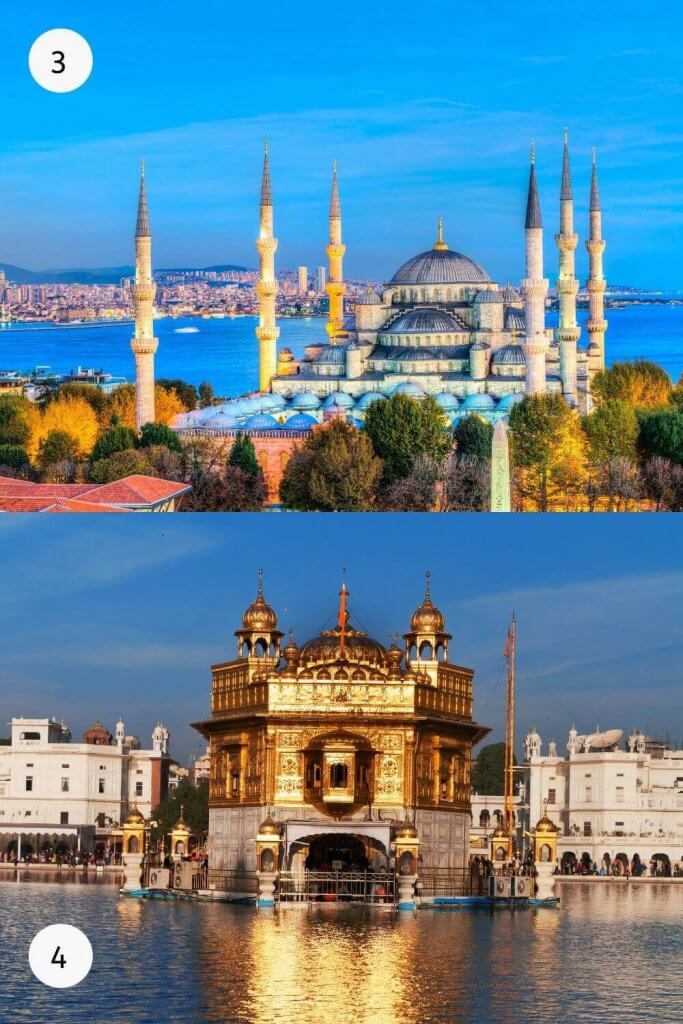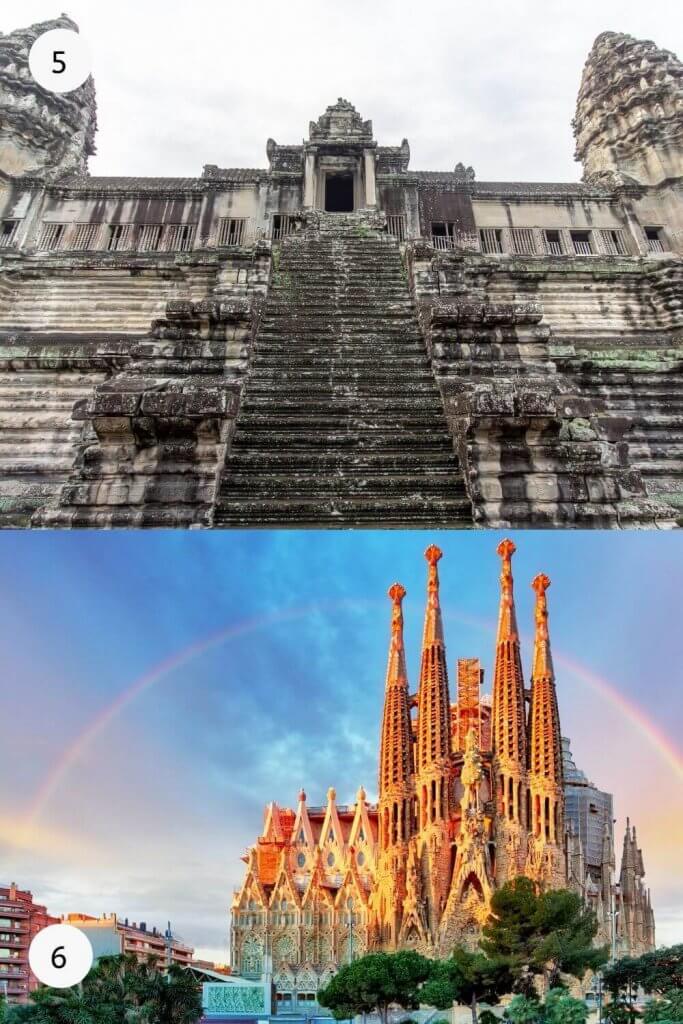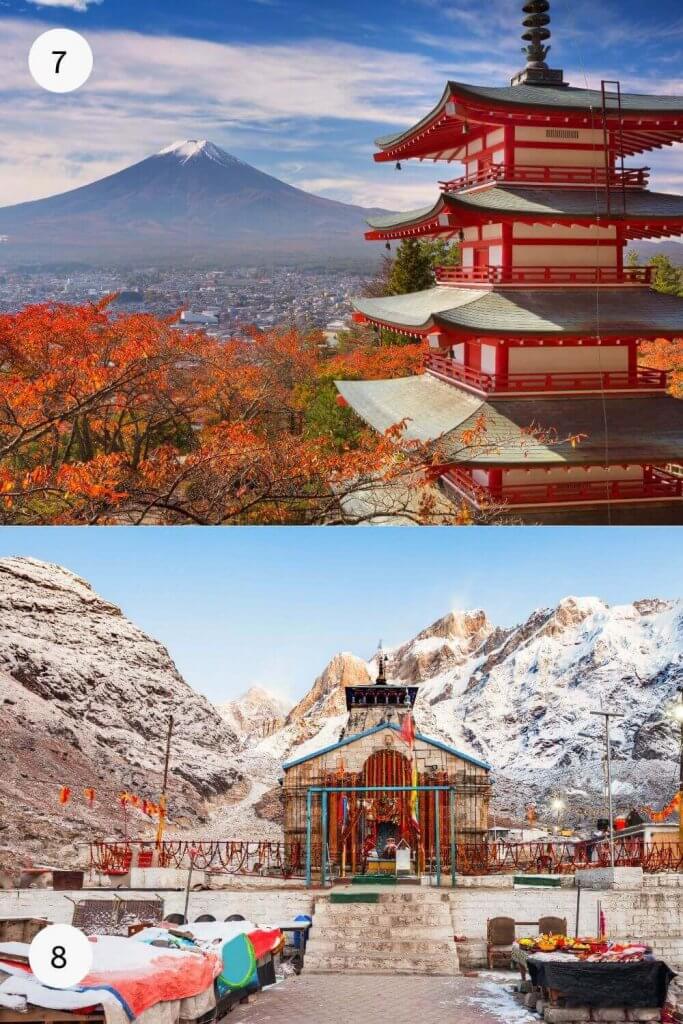Lately, I wrote about what worship is and now I would like to answer some of the frequently asked questions around the places of worship. As I am a big fan of creating sacred spaces and connecting in my sacred space to the One via rituals, I see this question of what is the place of worship important.
A sacred space is a place of worship for me. So one can say, what is sacred then. For me, sacred is the unspeakable which appears in the middle of the two realities. Those moments where I am aware of the continuous talk of the universe to me, I am aware of the appearance of the sacred as well.
Sacred is the unspeakable because I am unable to explain what I am experiencing at this moment. I can invite these moments to my life for guidance and meaning in a sacred space or a place of worship. Moreover, these moments can appear in the flow naturally independent of the place of worship. These are the times when any place in the world converts to a place of worship.
Why places of worship are important?
Worship, in itself, is a soothing and cleansing process. It hugs you just like a mother hugs her kid. You find the warmth, love, satisfaction, and a sense of protection always engirding yourself during the worship. Consequently, the place of worship contains high respect, regard, and importance. Thus, for its eloquence, dignity, and a feeling that it belongs to you, it is important.
Additionally, a place of worship serves as a community center for the people of every religion. People gather there and have the opportunity to share and know about each other, the welfare, and the sufferings. Hence, a worship place represents a religious worship area as well as a means of communication and unity among people.
Place of worship key features
Every place of worship is clearly a beautiful coalescence of religious and cultural architecture. Weaving the meaningful symbolism within, a place of worship has different features as per every religion. Following are some:
- Domes – domes are very much popular in churches, mosques, and Buddhist stupas. For churches, they represent heaven. On the other hand, at mosques, domes indicate the oneness of Allah. Moreover, in Buddhist stupas, domes denote water, one of the five pure elements.
- Towers or minarets – towers in churches represent heaven. Minarets in mosques are a source of giving Azaan (call to prayer). Also, conical spires in Buddhist pagodas denote heaven as well as wisdom.
- Prayer halls – large, spacious prayer halls are the integral parts of the place of worship. As a matter of fact, prayer halls belonging to different religions have different elements accordingly. Specific direction to face during prayer, idols to worship, and images of different gods, all are the prime elements.
- Altars, Minbars – the altar is an elevated platform where clergy in churches sit and give lessons and sermons. Similarly, in mosques, Minbar is the place where Imam sits and gives sermons. Moreover, in Hindu temples and homes as well, different statues of gods are kept on the altars.
- Office – every worship place has a small office that administers all the affairs. It deals with all the administration, studies, funds, counseling, etc.
- Store rooms – they are used to keep different religious books, furniture items, and religious stuff.
- Interior and exterior – beautifully decorated exteriors are common to every worship place. In addition to it, the interiors are adorned well with carpets, colorful tiles, ceramics, and mosaics.
Place of worship restrictions: guidelines for a place of worship
There are, unquestionably, some norms and rules to follow when visiting different worship places. Here, I have prepared a list for you according to different religions.
Muslim Mosques:
- Cover your heads using caps and scarves, etc.
- Take off the shoes outside the mosque.
- Do not sing, dance, or make noise inside.
- Wear proper and sober clothes. Besides, for women, full sleeves, pants covering the bottom of the legs, and covered head are required.
- Cameras and taking pictures are allowed except during prayer times.
- You should smell good and be bathed well. In addition to it, your mouth must not smell bad.
Hindu temples:
- Take off the shoes outside.
- Also, make sure to keep the leather items outside the temple.
- Wear proper clothing, with legs and shoulders decently covered.
- Donate using your right hand.
- Taking the pictures is allowed but permission beforehand would be more polite. Furthermore, a small donation will be a nice gesture.
Buddhist temple:
- Similar to mosques and Hindu temples, clothing must be proper. Besides, ensure to cover your shoulders.
- Take off your shoes and caps/hats outside.
- Pointing towards something makes a bad gesture. Therefore, try to indicate something with an open hand and use your right hand.
- Avoid touching the Buddha statues. Also, females are not allowed to touch the monks as well as to give something to them. In contrast, men are allowed to do that and that too with their right hands.
- It’s bad to turn your back to the Buddha statues. Therefore, the advice is to walk backward till you are a good distance afar from the statue.
- Stand in respect upon arrival of monks and nuns.
Churches:
- Firstly, it’s better to take permission to take pictures in a church.
- Visit with decent dressing and have your shoulders and legs covered.
Jain temple:
- You are not allowed to chew or eat inside the temple.
- You must silent your phones before entering.
- Maintain silence inside, it would be better.
- Bath well and wear washed clothes to visit the temple.
Jewish synagogue:
- Maintain decent dressing. Also, wear full sleeves.
- If you visit Jerusalem, avoid turning your back to the Western Wall while leaving. Thus, walk backward for a good long-distance. Then you can turn around.
- Orthodox synagogues allot segregated spaces for men and women. Therefore, consider maintaining that custom if you visit such a place.
- For men, the advice is to cover your head with specific caps called Yarmulke.
- Finally, during Sabbath day, you cannot take pictures.
How many places of worship are there in the world?
There are as many places of worship as there are religions in the world. Approximately, there are 14 types of worship places in accordance with different religions. But it’s difficult to count the total number of all the worship places existing in this world.
How many worship places are there in India?
There are roughly 3.01 million worship places in India according to the 2011 census.
Where to worship God?
Every religion has a specific place to worship. But, in my opinion, you can worship God anywhere. It’s just about a devoted heart, a beholding eye, and a submissive soul. And then any place will be your sacred space, letting you connect with God. A mosque, a temple, a church, or even a large grassland having trees around can become your sacred space.
Place of worship
Place of worship: A place of trees
And so, here I have some interesting facts for you. Oh yes, about worshipping the trees. Animism, as it’s called, it is one of the most ancient religions. As a matter of fact, specifically ancient European people were the followers. Some stories and customs are:
- For Romans, there was a sacred fig tree that they used to worship.
- Ancient Europeans especially used to go to the forests, cut the trees, and bring them back to their towns. They used to plant them outside their houses or just take them to every door. They did that in order to obtain blessings from the trees.
- Ancient Greeks worshipped the oak tree, linking it to the god Zeus. While ancient Romans considered the oak tree sacred with respect to Jupiter.
- Celtic people also gave high importance to the oak tree as they used its leaves in their religious ceremonies.
Place of worship: A temple
Temple is a term commonly used for the place of worship for different religions. Hindus, Buddhists, Jains, Greeks, Romans, etc use this term for their worship place.
Place of worship diversity: places of worship and religions
Indeed, diversity adds beauty, charm, and thrill to this world. Otherwise, life would be dull in any case. The same goes for the worship and its places. Different religions, their customs, and rituals, places of worship, all are captivating and unique at the same time. And learning about them all undoubtedly becomes so much interesting as well.
Which place of worship is this? Place of worship examples
Let me take you to some beautiful places of worship all around this world. Try to guess the name of the place of worship in the photo.
1. The Holy Kaaba, Mecca, Saudi Arabia, 2. Masjid-e-Nabawi, Medinah, Saudi Arabia, 3. Blue Mosque or Sultanahmet Camii, Istanbul, Turkey, 4. Golden Temple, Amritsar, India, 5. Angkor Wat, Krong Siem Reap, Cambodia, 6. Sagrada Familia, Barcelona, Spain, 7. Chureito Pagoda, 8. Mount Fuji, Japan, Kedarnath Temple, Kedarnath, India
Where Hindus worship? The place of worship for Hinduism
Hindus worship in the temples. They call it Mandir in Hindi. Having a diverse range of gods, there are different temples associated with different gods and goddesses.
Where do Jews worship?
The synagogue is the place of worship for Jews.
Where Christians worship? The place of worship of Christianity
Christians worship in churches.
Where Muslims worship? The place of worship of Islam for Muslims
The mosque is a Muslim worship place. Muslims call it Masjid, an Arabic word that means a place of prostration. Also, big congregational mosques are called Jami masjid.
Where Buddhists worship? The place of worship Buddhism
Buddhist temples – wat, stupa, vihara, chaitya, and pagoda.
Place of worship of Theravada Buddhism
Wat and Stupa.
Place of worship of Mahayana Buddhism
Pagoda, Vihara, Chaitya, and Candi.
Place of worship for Sikhism
Gurdwara is the name, meaning a door to the guru (Gur is for guru and dwara means door).
Place of worship for Confucianism
Confucian temple.
Place of worship Jainism
Jain temple or Derasar.
Place of worship for Zulu culture
Shembe church.
Place of worship of Shintoism
It is a Shinto temple or shrine called Jinja, which means ‘place of God’.
Place of worship for Baha’i
Baha’i temple. Another name is Mashriq-ul-adhkar, meaning the dawning place to remember God.
Place of worship Taoism
Daoguan is the name for Taoist temple.
Place of worship of Greeks
Greek Temple is the name for ancient Greek religions.
Synonyms to a place of worship
As you see the diversity in places of worship is huge. So this also reflects in the names of places of worship for each place in a different faith. The synonyms to a place of worship are; shrine, sanctuary, mosque, temple, church, house of God, monastery, house of worship, holy place, and sacred site, etc.
Place of worship quotes
Finally, let’s talk about some quotes. Following are some wonderful quotes:
Many are the places of worship, but few indeed are those who worship in spirit and in truth.
Khalil Gibran
When I think of a place of worship, I think of a place where one can sit and be reminded of all the things that are important outside our individual lives. To express spirituality, the architect has to think of the original material of architecture, space, and light.
Richard Meiyer
If you limit worship to where you are, the minute you leave that place of worship you will leave your attitude of worship behind like a crumpled-up church bulletin.
Tony Evans
I looked in temples, churches, and mosques. I found the divine within my heart.
Rumi
Conclusion
Above all, worship is love. Worship is all that you feel about God and how you connect with Him. Although a place of worship is a key element for every religion, nonetheless, worship oozes from the heart. Therefore, just look inside and find a beholding eye. Without a doubt, you will learn to worship anywhere. Absolutely, you will learn to make your sacred space and enjoy that undoubtedly.
If this article inspired you, you can also read these articles below:
What Worship Is?
Place of Worship for Buddhism, Christianity, and Islam
Below is a Pinterest friendly photo…. so, you can pin it to your Sacred Space Board!









